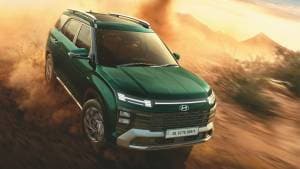2024 Hyundai Alcazar facelift review, first drive - the better Creta?
The Hyundai Creta has you more or less covered with the things you might want from a mid-sized SUV, and it consistently seems to top our comparison tests. So the Hyundai Alczar has the job of catering to the ones who may be looking for an added dose of luxury and flexibility in such a package. It's been a steady seller but with this new facelift has its appeal broadened?

2024 Hyundai Alcazar facelift Styling, dimensions, boot space
This 2024 Hyundai Alcazar facelift has grown by 60mm from the last car, although most of this is down to the new cosmetic changes. A better measure is that it is 230mm longer, 10mm wider and 75mm taller than the Creta.

But what Hyundai has done within these dimensions is more significant. There's now a more noticeable visual differentiation between the Creta and the Alcazar. The headlamps are largely similar but just like the Creta N Line, there's a distinct face here with the wide horizontal, darkened grille and the new interpretation of the 'H' lighting motifs in the DRLs. Also well done, in almost a Kia-like manner, are the various material finishes as seen on the grille and bumpers.

There's more of this to the side profile. So the bodywork is no different but there is a more polished feel here with the gloss black glass surrounds and the silver scuff plates in the doors. Also new are the 18-inch alloys. They are a size up from the standard Creta and get quite a sharp look.
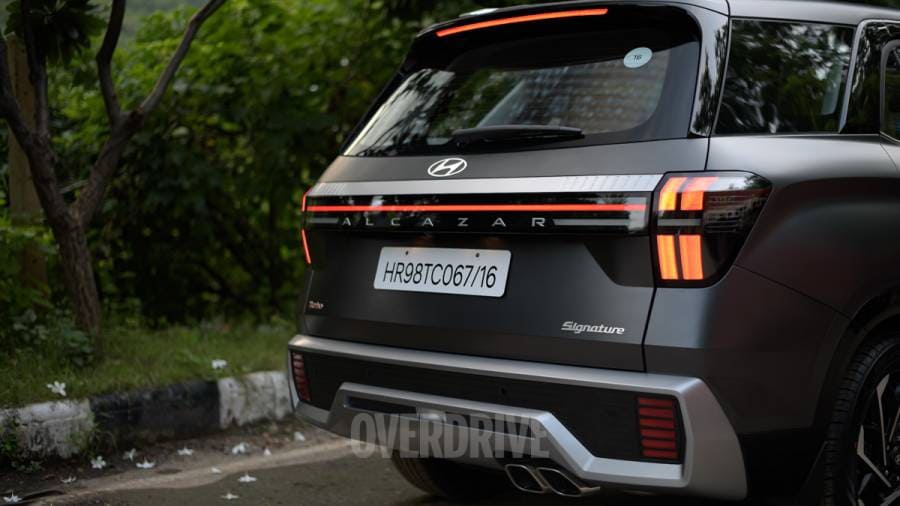
The rear has also taken on a fairly unique look. The two-part theme from earlier is carried over but the full-width effect and the vertical light cluster make this section resemble Hyundai's larger global SUVs the most. The accenting that goes with this below the windscreen and bumper creates a sense that this may be a more expensive car.

One of the ways in which the flexibility that this longer bodyshell provides is in the boot space. You have quite a usable 180 litre with all rows up, enough to cover you on a quick shopping run. But the third row folds flat fully to give you 579 litres. This is much more than most mid-sized SUVs and even betters a bunch of sedans. Helping this is that the wide opening and the flat load lip make it easy to handle luggage.
2024 Hyundai Alcazar facelift interiors, space practicality
As with the last Alcazar, the dashboard is shared with the Creta. The tan and gloss black theme with the silver highlighting gives this space a more classy sense. This goes well with the modern layout and its curved screen setups, slim vents and horizontal accents. While panel gaps and fitments could be tighter, something we noticed with the new Creta too, the plastics on the dashtop do seem to have taken on a softer feel to them. In keeping with this, the textures around the steering wheel and armrests also feel of a better quality than in the Creta.

A more significant change comes in the way of the slightly rearranged climate controls and centre console. You still get good toggles and dials for the climate and audio controls but the other physical buttons have now all turned capacitive touch panels. They look more modern but are nowhere near as easy to use on the move as on the Creta. On the flip side, the gearshift column is now better arranged. You have switches easily in reach and the centre armrest is now a sliding one adding to comfort.
The 10.25-inch screen is the usual Hyundai-Kia fare, so it's about as easy to use as you need it to be. The responses are slick enough, the menus are logical and most functions are a few taps away. So also get in-built navigation and the vast suite of connected features. As before, there's still no wireless Android/Auto or Apple Carplay. The Alcazar always got the digital instrument cluster, so that has been carried over largely unchanged. The dials are easy to read and the information presents itself cleanly.
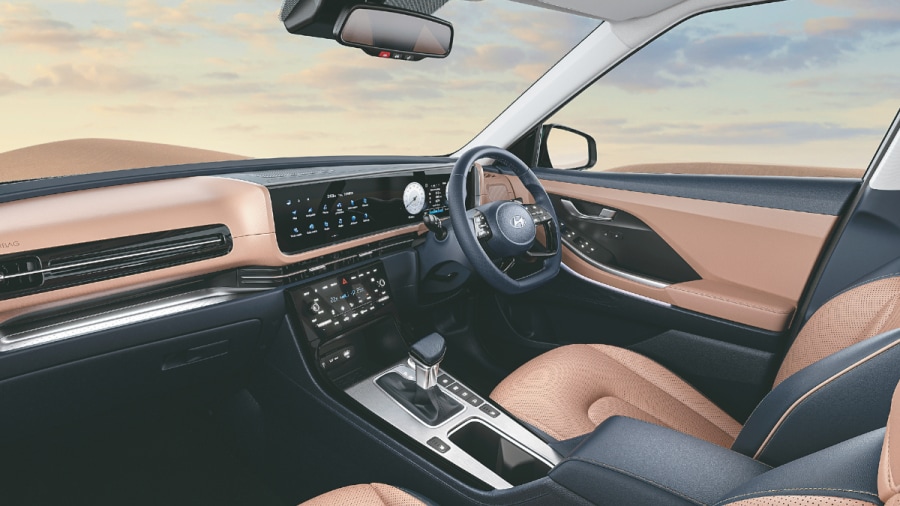
Another notable step-up is the new seats. They are much better contoured and more supportive than the Creta's and tire you out less over a longer journey. They continue to be ventilated but the driver's seat now has preset functions and the passenger seat too gets a powered adjustment. A good addition is the easy access function for the driver's seat.
With the six-seater version and the captain seats that it gets, the experience in the second row is largely similar to what it was before. The new seats make their way here too, being scooped out and adding to legroom in a small way from earlier, so it's a more comfortable space in that sense. This goes up a notch with the winged headrests and the extendable squabs. The latter though offer a limited range and may be best suited for taller passengers. The boss mode buttons however are a convenient way to maximize the legroom on offer if you get driven around a lot.
Those with a wider frame may prefer the bench option, however, given the contouring and width of these chairs. The panoramic sunroof and the slightly high placement of the seats can eat into headroom for taller passengers while legroom is adequate even though there is a 150mm wheelbase advantage over the Creta. This seems to be to accommodate the third row and the limited sliding range this calls for for these seats. But you still can get into a comfortable napping position with the good angle of recline that's on offer.

Unsurprisingly Hyundai has amped up features here too, so you now get ventilation here aside from the sunshades, wireless charger and tray table from earlier.
As before, accessing the third row is somewhat convoluted in this captain-seat version of the Alcazar. The second-row seats don't tumble-fold but Hyundai has tried to make life easier by clearing out a space in between these seats. The third row is best for children or smaller adults. But the space has been put to good use. A bit of adjusting lets you tuck your feet under the front seats and the scooped-out roof adds some headroom. The seatback and tall headrests are quite supportive too but as with many of these arrangements, you will be sitting in a crouched position that will be difficult for taller adults over an extended journey. But again, there are good amenities here. You get large storage bins and cup holders, type-C charging as well as separate blower controls and interior lighting.
2024 Hyundai Alcazar facelift features, safety
There's a pretty long list of features for the Alxzar that include LED lighting, auto headlamps, puddle lamps, powered and ventilated seats with memory, new auto wipers, a digital key, second-row seat ventilation and sunshades. The only real miss we could think of was a powered tailgate. The diesel loses out on a sunroof and a spare wheel to match its pricing to the petrol.
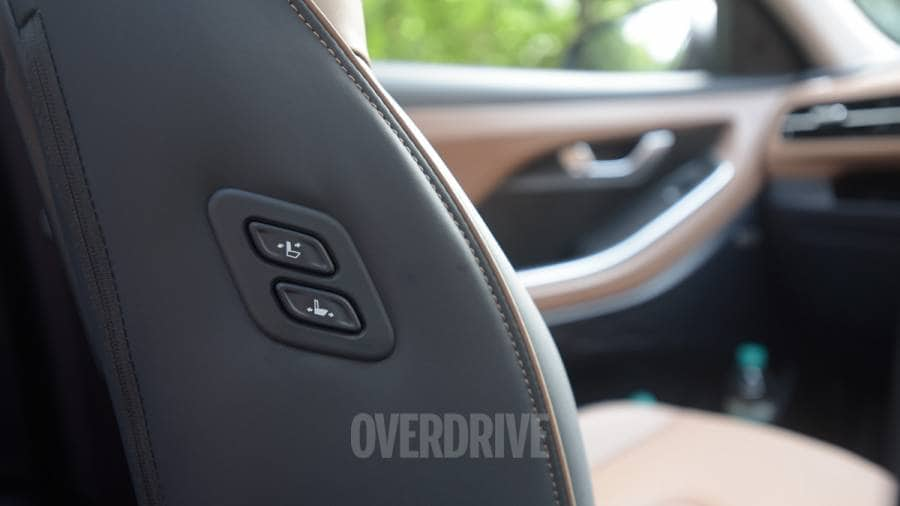
You get the full suite of Hyundai's level 2 ADS features as well as a new hill-descent control feature that works well enough.
2024 Hyundai Alcazar facelift driving impressions
There haven't been significant powertrain changes to this facelifted Alcazar from the last model, although the added strengthening and tuning changes that went into the Creta have been carried over here.
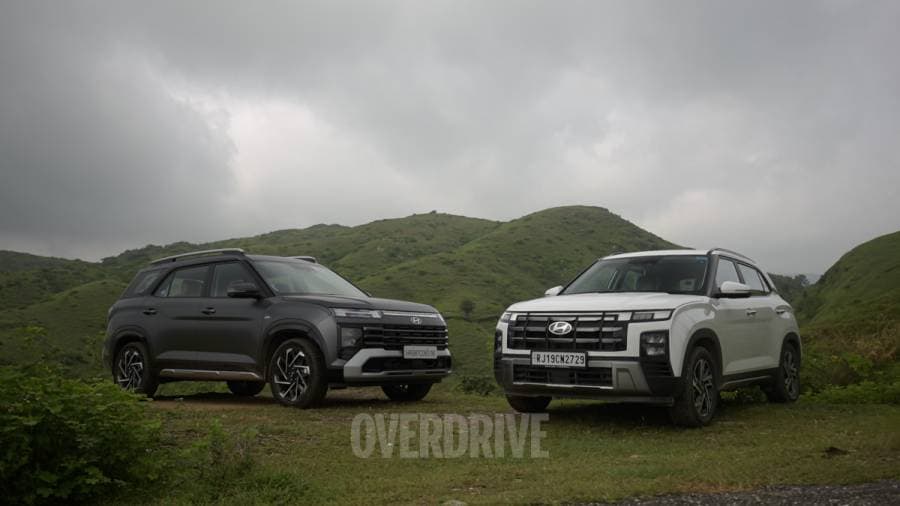
Seen here is the 1.5-litre turbo-petrol with its 160PS and 250 Nm, paired with the seven-speed DCT, so the driving experience is largely familiar. This motor's refinement continues to be a strong point. It's especially quiet and without too many vibrations under calm driving. As before, it takes some waking up but it's a linear experience that builds and the engine fully hits its stride. You have wide, easily accessed performance that makes for smooth driving. It doesn't sound the best but is effective. That said, the added weight of the Alcazar does show. It's a touch less sprightly than a similarly powered Creta in most driving situations, doing the 0 to 100 kmph sprint in 9.5s, but in the larger scheme of things, this is about as much daily performance as you might need.

The gearbox, like before, seems well-matched to the engine. It doesn't feel hesitant at lower speeds and usually has you right where you need to be in the powerband. You only really notice it in heavier driving where it could be a bit more aggressive with its shifts, say during a high-speed overtake. The Sport mode improves this a smidge, but for most needs the default Normal mode is good enough.
The Alcazar now carries that solid sense that the Creta got with its most recent update. So you get the feeling that it will take some punishment over some of our worse patches. The increased wheelbase works with this to give this SUV a better sense of stability. This is most apparent in straight-line highway driving but also seems to give it good composure around bends, helped by the larger wheels to an extent. Of course, the city-focused steering is easy but not the most engaging and while body roll is not especially apparent, the Alcazar feels its best when you aren't pushing its limits too much.
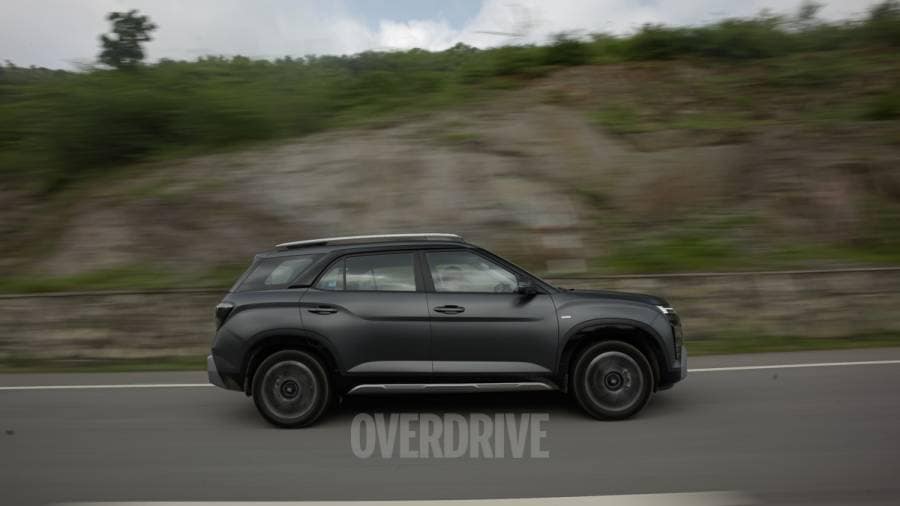
Also like the new Creta, there's a plushness to the ride that goes with the solid overall sense. Yes, the 18-inch wheels have brought with them a firm edge that shows up over broken roads but the feeling is not too harsh or unrefined. You aren't thrown around all too much and this improves at high speeds on well-paved surfaces into a steady experience.
2024 Hyundai Alcazar facelift prices, verdict
Priced between Rs 14.99 lakh and 21.55 lakh, the Alcazar costs up to Rs 1.4 lakh more than the Creta for the top versions. There could have been a touch more space for this in the second and third rows and a bit more differentiation in the dash design. But otherwise, this seems like a fair deal for the added features you get, the slightly more premium sense you get inside and out and the competent driving experience that's on offer.
Starts Rs 16.3 Lakhs
1493cc
Automatic
115
250
-NA-
Starts Rs 9.99 Lakhs
1353cc
Automatic
115
242
-NA-

